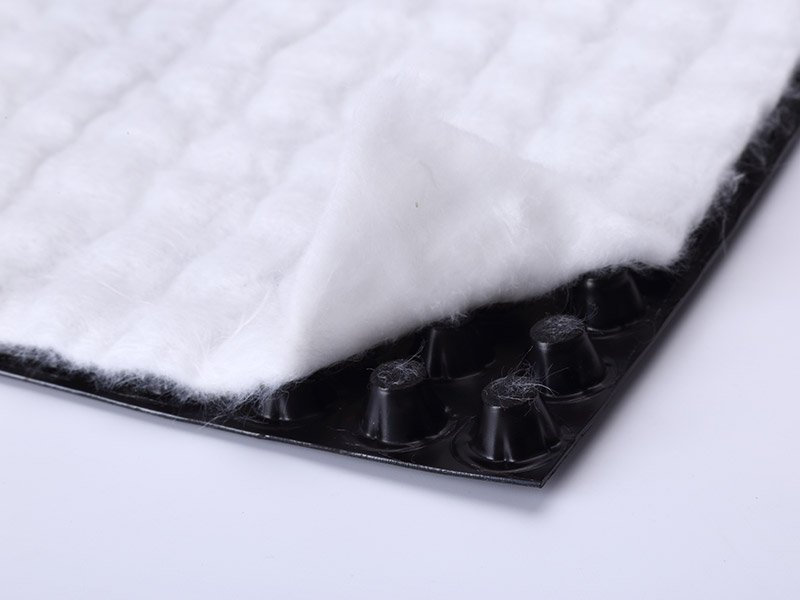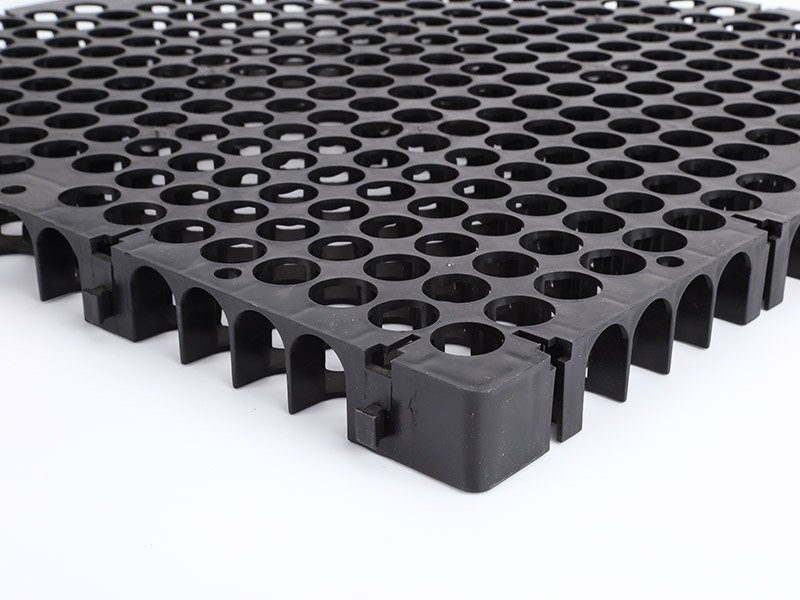Drainage cell and sheet drain are two distinct drainage boards used in construction and landscaping to manage water drainage effectively. While drainage cell and sheet drain serve similar purposes, drainage cell and sheet drain differ in terms of structure, materials, benefits, and applications.
Drainage cells are three-dimensional structures made of high-density polyethylene (HDPE) plastic with interconnected cells that allow water to flow through. The geotextile drainage cells are typically installed beneath pavements, roofs, and green roofs to manage storm water runoff and prevent water logging. Cellar drainage cells are lightweight, easy to install, and can be cut to fit any shape or size.
On the other hand, sheet drain is flat sheet made of various materials such as plastic, rubber, or geotextile fabric. Sheet drain mainly include geocomposite sheet drain, polypropylene sheet drain, HDPE sheet drain, and more. They can be installed vertically or horizontally against foundation walls to prevent water from penetrating the building. Sheet drain provides a barrier against moisture and can also be used as insulation.
BPM Geosynthtics is the leading sheet drain and drainage cell suppliers, we manufacture a complete line of drainage products for your demands. In this article, we will explore the key differences between drainage cell and sheet drain in terms of their structure, function, benefits and applications, aiming to provide a comprehensive understanding of these essential drainage solutions.

1. Different Structures
1.1 Structure of Drainage Cell
A drainage cell refers to a modular plastic product designed specifically for facilitating effective rainwater drainage. Its primary function is to create a void or empty space that enables efficient water drainage. Drainage cell has high strength,high compressive strength and doesn’t distort or burst molded PP as a protective material for waterproofing and provides ventilation for concrete slabs which alleviates heat induced stress and cracking.
Furthermore if the wall is cracked and no efficient drainage is present contamination from the soil such as salts and other corrosive elements will further contribute to the deterioration of the wall integrity.sheet drainage the most effective method of venting and maintaining consistent temperature on the wall surface by creating a substantial long term air pocket that will not crush over time.
1.2 Structure of Sheet Drain
Sheet drain is molded by PP material by heating and pressurizing which can not only create a drainage channel with a certain three-dimensional space support rigidity, but also can store water. The geocomposite sheet drain itself has two kinds of comprehensive function which is water storage and drainage. characteristics of storage and sheet drainis high spatial stiffness, compressive strength is obviously superior to the similar products, and can withstand extreme load conditions in the process of filling machinery rolling back in the planting roof. The dimple drain sheets have the functions of drainage in the construction layer, the infiltration of water in the soil, and the storage of the infiltration water.
2. Different Functions
2.1 Drainage Cell Fucntions
2.1.1 Stormwater Management
Drainage cells are designed to effectively manage stormwater by creating voids that allow water to drain efficiently. Helps prevent water buildup and damage to structures and surfaces.
2.1.2 Water Storage
Some drainage cells are equipped with storage features that allow rainwater to be collected and stored for later use. This feature is particularly useful for applications such as stormwater management and irrigation systems.
2.1.3 Improved Drainage
The modular, interconnected structure of the drainage cells provides multiple paths for water flow, facilitating improved drainage. This prevents flooding and ensures effective drainage even in heavy rain or flooded areas.
2.1.4 Soil Protection
Drainage cells act as a protective layer between the soil and the structure. It helps distribute weight and pressure evenly, reducing the risk of ground settlement and damage to the underlying soil structure.
2.1.5 Root Protection
In landscaping and green roof applications, drainage cells form a protective barrier for plant roots. It drains excess water while retaining the moisture your plants need for healthy growth.
2.2 Sheet Drain Functions
2.2.1 Drainage
Sheet drain is designed to drain water efficiently and direct water away from structures and areas where water can accumulate. Sheet drain provides a path for water to flow and prevents water buildup and potential damage.
2.2.2 Moisture Management
Sheet drain controls moisture by directing excess water away from the surface. It helps prevent moisture buildup that can lead to problems such as mold growth, deterioration of building materials, and loss of structural integrity.
2.2.3 Hydrostatic Pressure Relief
Sheet drain acts as pressure relief systems by relieving hydrostatic pressure on structures such as retaining walls and foundation walls. This helps prevent water from pooling behind these structures, which can cause structural damage over time.
2.2.4 Soil Filtration
The sheet drain contains a filter cloth that prevents soil particles from clogging the drainage channels. This ensures a continuous flow of water while preventing soil erosion and maintaining the long-term effectiveness of the drainage system.
2.2.5 Protection and insulation
Sheet drain forms a protective layer that seals membranes and other sensitive surfaces. It helps protect these materials from possible damage during backfilling and construction operations. Additionally, it acts as an insulator, reducing heat transfer and promoting energy efficiency.
3 Specifications of Drainage Cell and Sheet Drain
| No | Item | Sheet Drain Specifications | Drainage Cell Specifications |
| 1 | Material composition | 100% recycled PP | 100% recycled PP |
| 2 | Size | 500MMx500MMx35MM | 500MMx500MMx30MM |
| 3 | Colour | Black or orange(as your request) | Black (as your request) |
| 4 | Surface void area | 0.135 | 0.6 |
| 5 | Internal void area | 0.8 | 0.88 |
| 6 | Weight capacity | Above 35ton/m2 | Above 100ton/m2 |
| 7 | Compressive strength | Minimum.280KN/M2 | Minimum.900KN/M2 |
| 8 | Discharge capacity@1% gradient | 800 L/m2.s | 900 L/m2 |
| 9 | Weight per square meter | 2.3KGS/M2 | 3.6KGS/M2 |
| 10 | Capacity for 1x40HQ | 4800square meters (19200pcs) | 2000square meters (8000pcs) |
| 11 | Capacity for 1x20GP | 2000square meters (8000pcs) | 800square meters (3400pcs) |
4. Applications of Drainage Cell and Sheet Drain
Drainage cells are commonly suitble for the following applications:
- Green roofs and living walls.
- Sports fields and golf courses.
- Planter boxes and tree pits.
- Pavement systems and driveways.
- Subsurface stormwater management.
- Underground stormwater detention and infiltration systems.
Sheet drains find applications in various construction scenarios, including:
- Exterior foundation drainage.
- Basement and below-grade wall protection.
- Plaza decks and podiums.
- Bridge abutments and retaining walls.
- Vegetative roofs.
- Protection of below-grade waterproofing.


5. Installation of Drainage Cell and Sheet Drain
5.1 Sheet drain
Sheet drains are typically applied to the exterior surfaces of structures. Installation methods may vary, but they often involve fastening the boards to the substrate using mechanical anchors or adhesives. The boards can be applied horizontally or vertically, depending on the specific application.
5.2 Drainage Cell
Installing drainage cells typically involves excavating an area, laying a geotextile fabric as a base, placing the drainage cells in the desired configuration, and then covering them with additional geotextile fabric and backfill material. The cells can be stacked or interlocked to create the desired void depth.
6 Conclusion
In summary, drainage cells and sheet drains are essential components for water management in a variety of situations. Drainage cells are primarily focused on creating underground cavities for water storage and distribution, while slab drains are designed for surface water management and moisture protection of structures. The choice between the two depends on the specific needs of your project. In some cases, drainage cell and sheet drain can also be used in combination to achieve optimal drainage and water management solutions in complex construction and landscaping projects.





